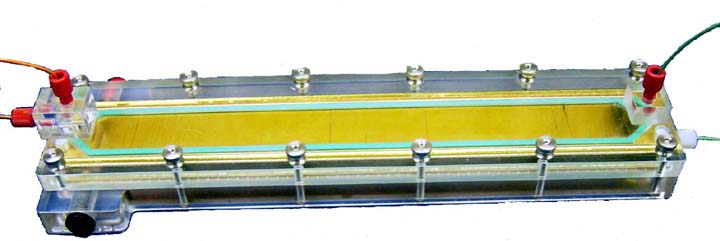ตำแหน่ง: นักวิจัยประจำห้องปฏิบัติการพิษวิทยาสิ่งแวดล้อม - Research scientist @ Lab. of Environmental Toxicology
หมายเลขโทรศัพท์: 02-574-0622 ต่อ 3204
อีเมล์: 
เวปไซด์ส่วนตัว: http://www.puiock-gallery.com/myself/index.html
เวปไซด์เกี่ยวกับงานที่ทำ: การประยุกต์ใช้งานเทคนิค Dielectrophoresis กับงานวิจัยทางพิษวิทยา http://dep.puiock-gallery.com
เวปไซด์แกลอรี่ภาพเขียน: ปุยอ๊อกแกลลอรี่ http://www.puiock-gallery.com
====== งานวิจัยที่กำลังดำเนินการอยู่ ======
Dielectrophoresis Field-Flow Fractionation System for Detection of Aquatic Toxicants
dFFF chamber
Sittisak Pui-ock,† Mathuros Ruchirawat,†‡ and Peter Gascoyne*§
Laboratory of Environmental Toxicology, Chulabhorn Research Institute, Bangkok, Thailand, Department of Pharmacology, Faculty of Science, Mahidol University, Bangkok, Thailand, and Department of Molecular Pathology, M.D. Anderson Cancer Center, University of Texas, Houston, Texas 77030
Received for review May 29, 2008. Accepted July 11, 2008.
Abstract:
Dielectrophoretic field-flow fractionation (dFFF) was applied as a contact-free way to sense changes in the plasma membrane capacitances and conductivities of cultured human HL-60 cells in response to toxicant exposure. A micropatterned electrode imposed electric forces on cells in suspension in a parabolic flow profile as they moved through a thin chamber. Relative changes in the dFFF peak elution time, reflecting changes in cell membrane area and ion permeability, were measured as indices of response during the first 150 min of exposure to eight toxicants having different single or mixed modes of action (acrylonitrile, actinomycin D, carbon tetrachloride, endosulfan, N-nitroso-N-methylurea (NMU), paraquat dichloride, puromycin, and styrene oxide). The dFFF method was compared with the cell viability assay for all toxicants and with the mitochondrial potentiometric dye assay or DNA alkaline comet assay according to the mode of action of the specific agents. Except for low doses of nucleic acid-targeting agents (actinomycin D and NMU), the dFFF method detected all toxicants more sensitively than other assays, in some cases up to 105 times more sensitively than the viability approach. The results suggest the dFFF method merits additional study for possible applicability in toxicology.
For full detail of the current paper, please visit http://pubs.acs.org/cgi-bin/abstract.cgi/ancham/2008/80/i20/abs/ac801095p.html
